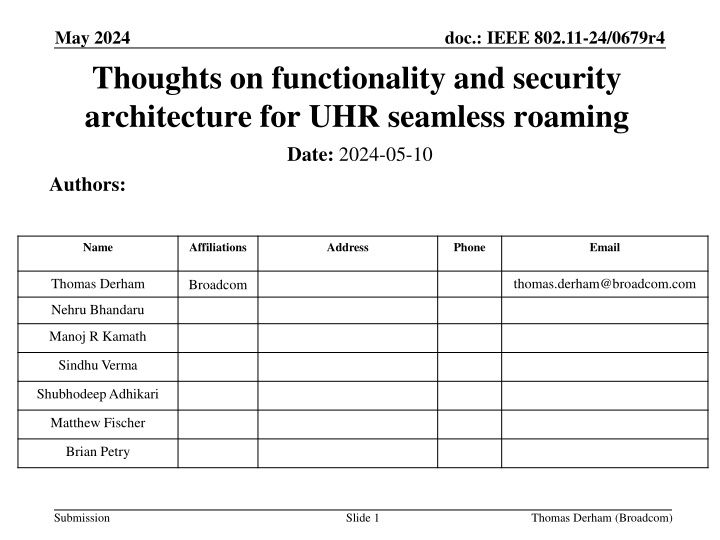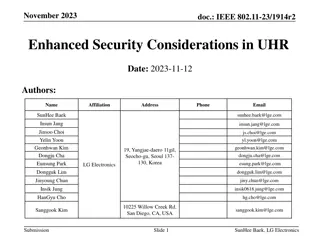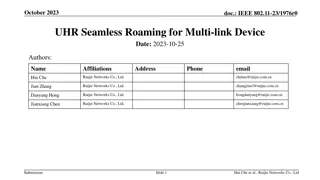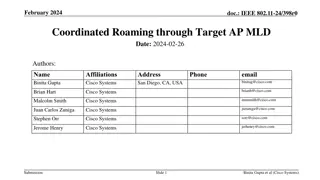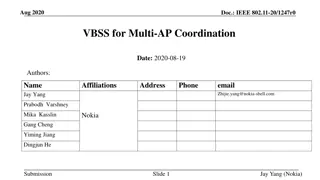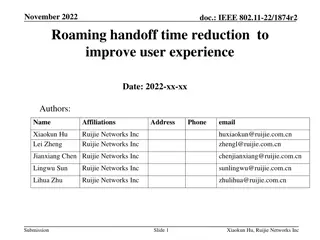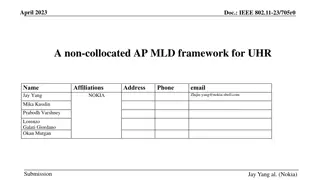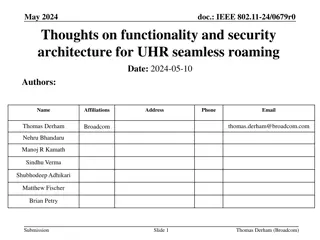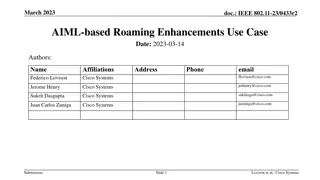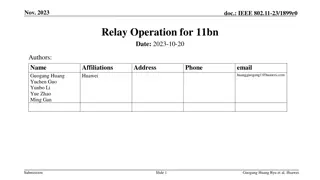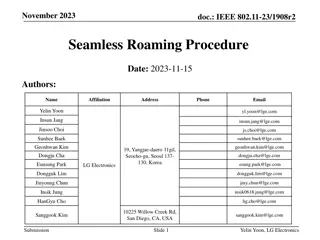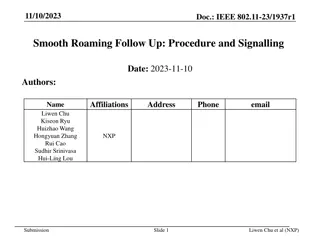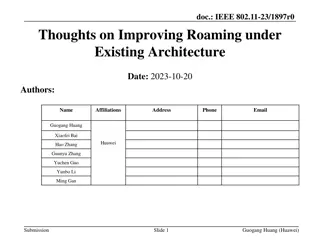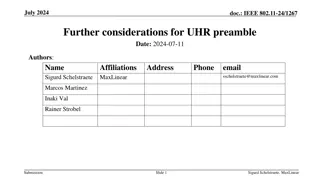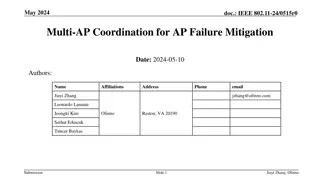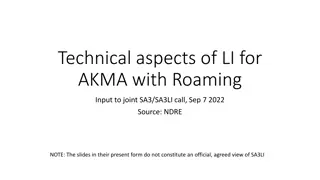Functionality and Security Architecture for UHR Seamless Roaming
In May 2024, an IEEE submission discusses high-level requirements, new capabilities, and security framework needs for Ultra-High Rate (UHR) seamless roaming. It outlines a generic roam sequence, data path specifics, and signaling triggers for successful roaming between multiple AP MLDs. Key considerations include preserving data context and ensuring secure data exchange during the roaming process.
Uploaded on Feb 28, 2025 | 0 Views
Download Presentation

Please find below an Image/Link to download the presentation.
The content on the website is provided AS IS for your information and personal use only. It may not be sold, licensed, or shared on other websites without obtaining consent from the author.If you encounter any issues during the download, it is possible that the publisher has removed the file from their server.
You are allowed to download the files provided on this website for personal or commercial use, subject to the condition that they are used lawfully. All files are the property of their respective owners.
The content on the website is provided AS IS for your information and personal use only. It may not be sold, licensed, or shared on other websites without obtaining consent from the author.
E N D
Presentation Transcript
May 2024 Thoughts on functionality and security architecture for UHR seamless roaming Date: 2024-05-10 Authors: doc.: IEEE 802.11-24/0679r4 Name Affiliations Address Phone Email Thomas Derham thomas.derham@broadcom.com Broadcom Nehru Bhandaru Manoj R Kamath Sindhu Verma Shubhodeep Adhikari Matthew Fischer Brian Petry Submission Slide 1 Thomas Derham (Broadcom)
May 2024 doc.: IEEE 802.11-24/0679r4 Introduction There has been agreement (e.g. [1], [2]) on some basic requirements for UHR seamless roaming, whereby: the non-AP MLD remains in State 4 throughout a successful roam from one AP MLD to another AP MLD the non-AP MLD has only a single point of connection to the DS at a given time except when the non-AP MLD receives buffered DL frames with Serving AP MLD after switching its point of connection to the Target AP MLD forwarding of buffered data packets over the DS between Serving AP MLD and Target AP MLD is also possible during roaming procedure, (some of) the context related to a non-AP MLD is exchanged between AP MLDs such that the data exchange context is preserved In this submission, we discuss and propose: High-level requirements for UHR seamless roaming A description of new capabilities to achieve these requirements Security framework requirements with a caution against some alternative proposals to share encryption keys cross multiple AP MLDs Baseline roaming performance and focus for enhancements Submission Slide 2 Thomas Derham (Broadcom)
May 2024 doc.: IEEE 802.11-24/0679r4 High-level requirements Generic roam sequence implied by so-far agreed requirements initial auth/assoc to AP MLD1 roam to AP MLD2 AP MLD2 s1 s4 non-AP MLD s1/s2 s4limited s4 s1 AP MLD1 State 4 (s4) data path with AP MLD1 State 4 (s4) data path with AP MLD2 Limited DL data path for buffered data delivery from AP MLD1 Non-AP MLD is always in State 4 with one AP MLD in the network Additionally, for a short period after roam to Target AP MLD2, a limited data path for buffered data delivery might continue to exist with Serving AP MLD1 to allow remaining DL data to be flushed Roam signaling exchange(s) trigger (*): (0) initiation of roaming procedures (1) capability exchange (per-link and per-MLD) and security setup (2) context exchange to AP MLD2 (3) establishment of OTA data path (State 4) with AP MLD2 (4) DS mapping update (to forward DL traffic to AP MLD2) * This list does not imply the ordering of triggers or the number of signaling messages Submission Slide 3 Thomas Derham (Broadcom)
May 2024 doc.: IEEE 802.11-24/0679r4 High-level requirements Problem statements and solution requirements Problem (1): Roams may not be triggered when needed, especially in mobility, resulting in emergency scans when current link fails, causing outage/disruption to data flows Client devices cannot continuously scan for off-channel transition candidates due to (a) power consumption limitations and (b) impact on existing link (depending on implementation) Networks cannot continuously monitor for client devices from other off-channel APs Client devices rarely transmit off-channel, especially if using passive scan Hence, measurement data needed by roaming/steering algorithms may be unavailable or unreliable Incomplete and/or stale bidirectional RSSI measurements Incomplete, unreliable and/or unprotected link/AP scoring metrics (e.g. channel utilization, WAN capacity/latency) In addition, roaming/steering algorithms tend to be conservative in triggering roams in order to: avoid link disruption due to (frequent) roam events avoid ping-pong / thrashing roams, particularly if both network-side and client-side roaming/steering algos are active avoid higher-layer disruption (e.g. IP change), bill shock, etc, if algorithm triggers network switch (e.g. to cellular) Candidate assessment No_action Roam_trigger[AP_MLD_Addr] Active measurement/metric collection (*) Passive measurement/metric collection (**) Collection_trigger Solution requirements (see details in Annex 1): Mutual exchange of initial candidates for future roams within roam signaling, to minimize additional exchanges Include RCPI, timestamps and other link scoring metrics (e.g. BSS Load) for each roam candidate (also in BTM Request) Mutual exchange of network topology, and scope of roaming/steering algorithms Define deterministic roam behavior if network has verified a Target AP MLD should meet QoS requirements Tunneled probing of candidate AP MLD(s) via Serving AP MLD, to minimize off-channel operations Submission Slide 4 Thomas Derham (Broadcom) (*) e.g. active scan, off-channel passive scan, send measurement request to peer (**) e.g. current link metrics (PER, MCS, ...), on-channel passive scan, receive unsolicited measurement report from peer
May 2024 doc.: IEEE 802.11-24/0679r4 High-level requirements Problem statements and solution requirements (2) Problem (2): Once a roam is triggered, roam procedures themselves cause outage/disruption to data flows Data exchange suspended during (off-channel) authentication/reassociation exchanges with target AP except, potentially, for clients capable of simultaneous Tx/Rx on both channels Data exchange with Target AP may be suspended, inefficient or insufficiently prioritized until MAC states are re- established (e.g. BA agreement, MSCS/SCS rules) Data packet loss and/or duplication (e.g. DL packets buffered at Serving AP may be lost, dirty scoreboard on roam) alternatively, implementations might defer roam until buffers are empty and scoreboard is clean, which can lead to similar emergency roam scenario as on previous slide Roam failures or delays (e.g. association comeback procedures) occur with non-negligible probability e.g. security (SA Query / PMF) related [can also be due to insufficient link quality or excessive roams - see previous slide] Solution requirements (details in following slides): Allow all roam exchanges with target AP (e.g. reassoc req/resp) to be tunneled over DS via Serving AP For scenarios where roam is triggered while link quality with Serving AP is still good Enable roam to occur with a minimal number of exchanges For scenarios where roam exchanges are directly with Target AP due to poor link quality with Serving AP Enable context transfer over DS to target AP, to avoid post-roam exchanges for MAC state re-establishment Provide mechanisms for retrieval of buffered data at Serving AP, and optimization of delivery order requirements, depending on higher-layer requirements of flows in a given TID Ensure roaming security framework is robust to avoid security-related roam failures / delays Submission Slide 5 Thomas Derham (Broadcom)
May 2024 doc.: IEEE 802.11-24/0679r4 Description of new capabilities Control plane context exchange It should be possible to negotiate what context is transferred on a roam (level of granularity TBD) Block ACK Experimental results (see later slides) indicate that ADDBA exchanges take a few ms to begin, and then take a few more ms to complete, and this is the dominant cause of outage in an optimized design Data transfer does not start (or is inefficient) until ADDBA exchanges complete Optimal design of what BA context is transferred depends on data plane handling during roam see next slides SCS Disruption to QoS-sensitive flows might occur if there is a delay in re-establishing SCS state after roam SCS parameters are generally semi-static so can be transferred over the DS with minimal downside e.g. any changes to SCS agreements after a context exchange has been initiated would be lost MSCS Similar considerations to SCS, but should allow current derived MSCS rules (IP tuple->UP) at Serving AP MLD to be transferred to Target AP MLD, in addition to the (semi-static) contents of MSCS Descriptor Note: If other TID assignment policies exist (e.g. based on DPI), they should also be transferred to target AP MLD in a proprietary manner - If TID assignment of packets is different on Serving and Target AP MLDs, any attempts to preserve the TID s state (e.g. BA agreement) would be futile Other MAC states (e.g. TWT) Maybe nice-to-have in theory, but complex to transfer synchronized timing state, and may need renegotiation e.g. conflict with existing TWT agreement at Target AP MLD Generally less impactful on link performance even if state is not transferred and need to be reestablished Submission Slide 6 Thomas Derham (Broadcom)
May 2024 doc.: IEEE 802.11-24/0679r4 Description of new capabilities A: Data plane handling for mainstream network implementations Design targeting support for zero-packet-loss roams in mainstream network implementations, i.e.: Mass-market AP designs, and/or Non-ideal backhaul, and/or Loosely coupled AP-to-AP interfaces (distributed control plane) Design philosophies: Minimize additional complexity on data path within APs Limit the amount of control signaling between APs No data transfer (over DS) between APs: non-AP MLD retrieves buffered DL data directly from Serving AP MLD Enable non-AP MLD to retrieve buffered DL data from (previously) Serving AP MLD after roam using: Signaling within roam exchanges to indicate buffer state at Serving AP MLD (i.e. whether buffered data exists) Signaling of remaining buffer state during data delivery (e.g. so non-AP MLD knows when it has received all data) Note: Needs careful design since buffered data size could increase at any time until the DS mapping completes A timeout period, to avoid indefinite connection in case if DS update fails or the AP MLD generates local traffic Definition of which class 3 frames can be transmitted in this state: DL Data (unicast only?), BA, mgmt? Consider frame exchanges to assist concurrent operation by multi-radio non-AP MLDs Note: Affiliated APs of Serving and Target are not of same AP MLD, so MLO features (e.g. eMLSR, TTLM) cannot be used across links Ability for non-AP MLD to choose whether to retrieve any or all of the buffered data for a given TID Buffered data retrieval implies some disruption to data path with Target AP MLD, especially when on different channels For some flows. zero-packet loss (especially where in-order delivery is enforced) might be undesirable, e.g. stale packets Generally, allow per-TID control of in-order delivery (if higher layers can support) see later slide Submission Slide 7 Thomas Derham (Broadcom)
May 2024 doc.: IEEE 802.11-24/0679r4 Description of new capabilities A: Data plane handling for mainstream network implementations [2] Block ACK agreement context exchange for DL TIDs Preferred scenario - only the semi-static parameters of each DL BA agreement need to be transferred i.e. fields in ADDBA s Block Ack Parameter Set field (TID, Block Ack Policy, Buffer Size, etc), BA Timeout Various low-complexity design options exist for this context exchange, e.g. lightweight context exchange over DS, OR lightweight context transfer from non-AP STA (e.g. embedded within protected roam setup exchanges) Therefore, the transmit buffer control status (e.g. WinStartO) at Target AP MLD is reset; while scoreboard, duplicate detection and reordering at the non-AP MLD is handled separately for each AP MLD This approach has advantages compared to SN continuity due to handling of buffered DL data (see later slide) Block ACK agreement context exchange for UL TIDs Similar to above i.e. semi-static parameters of each DL BA agreement are transferred so the scoreboard and reordering buffer at Target AP MLD are reset Or, as a variant, if WinStartB (*) is also transferred it allows SN continuity in uplink i.e. non-AP MLD can continue to use already-assigned SN values for MSDUs in its transmit queue Examples illustrating this approach are discussed on the next slides Submission (*) Note: WinStartB of UL TID is the SN of the first MSDU not yet successfully received (and so not yet passed up to DS) Slide 8 Thomas Derham (Broadcom)
May 2024 doc.: IEEE 802.11-24/0679r4 Description of new capabilities A: Data plane handling for mainstream network implementations [3] Downlink TID example (with buffered data delivery) Packet Index SN Tx Status packets: N+1, N+2, ... packets: 1, 2, ..., N N = last packet in buffered queue when DS mapping update Packet index SN switch N N+4 3 DS complete --- AP MLD1 AP MLD2 N+3 2 100+M= M 100+M -- / WinStartO + WinSizeO N+2 1 --- --- -- / L = last packet transmitted when CX is sent to AP MLD2 N+1 0 Packet index SN Packet index SN Rx Status L 100+L non-AP MLD --- --- N+4 3 M 100+M -- / 4 104 N+3 2 102=WinStartO 3 103 --- --- .. / N+2 1 2 102 4 104 N+1 0 1 101 3 103 102 Observations: Packet indices up to N are buffered at AP MLD1 at the time DS mapping update completes Number of buffered packets (N-1) might be large compared to WinSizeO (e.g. 256), and might be (much) larger than L e.g. due to a packet burst arriving at AP MLD1 after CX but before DS mapping update completes note: maximum packet burst size may depend on application/codec or flow control window size (e.g. TCP, QUIC), and can be quite large note: draining of buffer at AP MLD1 might be slow due to relatively poor link quality at roam Packets M+1 thru N might not yet have been allocated SNs 1 101 Submission Note: Packet index is simply an index that indicates the order of the (A)MSDU packets sent by higher layers (it does not refer to PN) Slide 9 Thomas Derham (Broadcom)
May 2024 doc.: IEEE 802.11-24/0679r4 Description of new capabilities A: Data plane handling for mainstream network implementations [4] Downlink TID example (with buffered data delivery) In-order-delivery TIDs: For in-order delivery, Non-AP MLD either forwards to higher layers, or drops, all data from AP MLD1 before forwarding to any data arriving from AP MLD2 to higher layers Non-AP MLD might, for a given TID, request AP MLD2 to buffer any DL data until it indicates it is ready (i.e. Non-AP MLD has finished processing all data from AP MLD1) In this case, the reordering buffer is simply reset to receive data from AP MLD2, once all data from AP MLD1 has been processed and forwarded to higher layers Alternatively, Non-AP MLD might, for a given TID, receive DL data from AP MLD2 while it is still receiving data from AP MLD1 Pros and cons: Avoids incurring additional latency on data from AP MLD2 (since over-the-air transfer of this data can be done in parallel ); however if radio resources are shared for links with both AP MLDs, this might result in higher latency on (older) data received from AP MLD1 In this case, Non-AP MLD stores packets from AP MLD2 in a separate (reordering) buffer, and only begin forwarding them to higher layers once all data from AP MLD1 has been forwarded to higher layers note: assume partial-state operation where scoreboard cache is deleted after each TXOP (and therefore only applies to a single AP MLD at a time) If necessary, a non-AP MLD with memory constraints on the total size of (reordering) buffers could indicate smaller Buffer Size values for use with AP MLD1 and AP MLD2, until all data from AP MLD1 has been processed e.g. Buffer Size for AP MLD1 becomes SNmaxB-WinStartB , or half of the total memory size (whichever is larger) where SNmaxB is the current largest SN of received frames from AP MLD1 note this also causes WinSizeO and WinSizeR to change accordingly once all data from AP MLD1 has been processed, the buffer (for AP MLD2) returns to full size Each buffer operates independently in terms of SN space. Therefore, in principle there is no limitation on the amount of data that can be retrieved from AP MLD1, and no issue if more data arrives in AP MLD1 s tx buffer after the CX has occurred Retransmissions (e.g. packet index 2) and duplicate detection (e.g. packet index 3) handled by each buffer independently Replay detection is handled for each AP MLD independently see later discussion on PTKs and PN space Submission Slide 10 Thomas Derham (Broadcom)
May 2024 doc.: IEEE 802.11-24/0679r4 Description of new capabilities A: Data plane handling for mainstream network implementations [5] Downlink TID example (with buffered data delivery) In-order-delivery-disabled TIDs: For in-order-delivery-disabled case (assumed opt-in based on support from higher layers), Non-AP MLD forwards data received from AP MLD2 to higher layers even when (older) data from AP MLD1 is still pending reception. Two possible variants: Variant 1: Data received from a given AP MLD is delivered in-order with respect to other data from the same AP MLD Variant 2: Data is delivered to higher layers as it is received, i.e. data from a given AP MLD might be delivered out-of-order both respect to data from the other AP MLD and other data from the same MLD [not necessarily limited to roaming] By definition, Non-AP MLD, for a given TID, receives DL data from AP MLD2 while it is still receiving data from AP MLD1 Similar implementation as per previous slide, i.e. separate reordering buffers for each AP MLD including same duplicate detection logic ... except that non-AP MLD forwards received MSDUs to higher layers even when the baseline criteria (e.g. contiguous SNs starting from WinStartB) are not met Note: If instead the design were to target SN-continuity for DL TIDs, various issues would arise due to the buffered DL data delivery: Transmit buffer control parameters (WinStartO, WinSizeO), and an indication of the largest SN assigned by Serving AP MLD, would need to be transferred between AP MLDs The amount of buffered data to be transferred (100+N) may be large, and is unknown at the time the CX occurs (at which time the largest used SN is 100+L). It is not realistic to introduce a gap to cover SN assignment for buffered data The gap must be small compared to the BA window size, yet the amount of buffered data (N-1) might even be large compared to the BA window size Buffered data beyond the gap size would have to be discarded, so zero-packet-loss would not be achieved Reduces SN space that can be used for data from Target AP MLD while data from Serving AP MLD is still pending Additional real-time synchronization between AP MLDs would be required to forward the window as buffered data is received Submission Slide 11 Thomas Derham (Broadcom)
May 2024 doc.: IEEE 802.11-24/0679r4 Description of new capabilities A: Data plane handling for mainstream network implementations [6] server Uplink TID example switch Packet index SN Rx Status Packet index SN DS AP MLD1 AP MLD2 4 104 6 4 (or 106) 3 103 5 3 (or 105) 2 102 4 2 (or 104) 3 1 (or 103) Packet index SN Tx Packet index SN 1 101 non-AP MLD 2 0 (or 102) Status 4 104 6 4 (or 106) 3 103 5 3 (or 105) 2 102 4 2 (or 104) 1 101 3 1 (or 103) In-order-delivery TIDs: UL packets that have SN equal or greater to the first packet for which an Ack has not been received from AP MLD1 (packet index 2 in this case), are (re)sent fresh to AP MLD2 in order On roam, AP MLD1 flushes its reorder buffer and forwards to the DS packets up until the first hole (up to packet index 2 in this case) If necessary, AP MLD1 can indicate to AP MLD2 that it can begin forwarding (in order) packets it has received to the DS There is a small but tolerable probability of undetected duplicates reaching the DS e.g. where non-AP STA resends packet index 2 to AP MLD2, even though it has already been forwarded to DS by AP MLD1 In-order-delivery-disabled TIDs: Similar to above, except AP MLD1 forwards packets to DS irrespective of holes in reordering buffer, non-AP STA only re-sends to AP MLD2 packets for which it has not received Ack, and AP MLD2 forward packets to DS without waiting for AP MLD1 2 0 (or 102) Submission Slide 12 Thomas Derham (Broadcom)
May 2024 doc.: IEEE 802.11-24/0679r4 Description of new capabilities B: Data plane handling for specialized/centralized networks Design targeting zero-packet-loss roams in specialized/centralized network implementations, i.e.: Specialized AP designs, and Ideal backhaul (e.g. dedicated multi-Gigabit wired local backhaul), and Tightly coupled AP control planes and/or centralized upper MAC architectures Design philosophies: Additional roam performance gains leveraging the specialized network implementation Assume buffered data and dynamic BA context can be transferred between AP MLDs over backhaul/DS implies AP design is able to retrieve buffered DL data at various level of the stack (e.g. within OS kernel / packet accelerator, driver, hardware, etc) in order to forward to the Target AP MLD For downlink TIDs, assume transfer of buffered DL data over backhaul/DS is in form of MSDUs Most buffered data is within larger queues prior to SN assignment and MPDU conversion Alternative designs (e.g. centralized encryption / upper MAC) would be proprietary and assumed handled transparently Assume complete transmit buffer control status is also transferred For uplink TIDs, assume reordering buffer status, and possibly buffer contents, are transferred Buffer status: WinStartB, WinEndB, WinSizeB,, and a record of the SNs that have been received but not forwarded to DS Advantage that (referring to previous slide) AP MLD2 would know that SN 102 was already received by AP MLD1 and forward to DS, so could detect and discard the duplicate if non-AP MLD (re)sends it to AP MLD2 Support needed in the standard to support this architecture should be fairly lightweight Mostly vendor-specific implementation, mostly transparent to the non-AP MLD Submission Slide 13 Thomas Derham (Broadcom)
May 2024 doc.: IEEE 802.11-24/0679r4 Security considerations PTK derivation On roam, a new and unique PTK should be derived for use with Target AP MLD ... assuming that TK is used as cipher (e.g. with GCMP) to encrypt unicast data and mgmt frames Especially for design targeting mainstream network implementations Key derivation should be performed out of the critical path Key derivation material exchanged during roam signaling that will occur anyway Embed A/S-Nonce or A/S-EphemeralPub, and PTK-confirming MICs in roam signaling messages Note these messages might be exchanged directly with target AP MLD, or tunneled via Serving AP MLD PTK derived as either: (regular AKM style, using A/S-Nonce): PTK = KDF-Hash(PMK, SNonce || ANonce || MLD_addresses ... ), or (PASN / 11bi style, using A/S-EphemeralPub): PTK = KDF-Hash(PMK, MLD_addresses || DHss) where DHss is Diffie-Hellman shared secret (provides Perfect Forward Secrecy PTK is protected even if PMK is compromised) Example sequences: (either sent directly, or via Serving AP MLD): 3-message 4-message non-AP MLD Target AP MLD non-AP MLD Target AP MLD Initiate_Context_Transfer, LinkSetupReq, S-Nonce/EphPub Initiate_Context_Transfer, S-Nonce/EphPub Confirm_Context_Transfer, A-Nonce/EphPub Confirm_Context_Transfer, LinkSetupResp, A-Nonce/EphPub, MIC(key=PTK-KCK, MLD_addresses || Msg2) Reassoc_Req, DS_Update_Req, MIC(key=PTK-KCK, MLD_addresses || Hash(Msg1) || Msg3) Reassoc_Resp, MIC(key=PTK-KCK, MLD_addresses || Hash(Msg2) || Msg4) DS_Update_Req, MIC(key=PTK-KCK, MLD_addresses || Hash(Msg1) || Msg3) Submission Slide 14 Thomas Derham (Broadcom)
May 2024 doc.: IEEE 802.11-24/0679r4 Security considerations PTK derivation concerns with PTK sharing Some other submissions have proposed sharing the PTK across AP MLDs in the network Even though derivation of new/unique PTKs would not compromise roam performance Note that TK compromise allows the attacker to passively decrypt, or actively inject or modify packets e.g. see Appendix A Importance of Uniqueness Requirement on IVs of NIST SP 80038D [5] Other potential issues with flawed PTK management include replay detection failure There is an expectation that new versions of technologies improve security, and certainly avoid regressions Modern network security best practices (e.g. zero-trust, resiliency) emphasize, where possible. avoidance of fragility to catastrophic failure even if base assumptions are not met (e.g. due to implementation issues, compromise of assumed- secure network perimeters/channels), e.g. [8], [9] Several concerns with PTK sharing are highlighted in these slides: (A) Regression in key hygiene / key separation In all RSN security mechanisms in baseline, there is a clear key hierarchy, and a PTK is a pairwise secret If a PTK is compromised, there is no impact on security of the connection between the non-AP MLD and any other AP MLD Note: PTKs are short-term pairwise secrets that directly encrypt traffic sent over the air, and therefore are particularly vulnerable to attack PTK sharing is not comparable to PMK Caching - since PMK is a key-generating key, not an encryption key also note in 802.11, PMK caching is defined for use with the same AP MLD (so-called OKC is proprietary and has known interop issues) On the contrary, in other proposals in which it is suggested the same PTK is used as a non-AP MLD roams across many AP MLDs in the network, knowledge of the PTK is shared by many parties In a push model, N + 1 entities know the PTK, where N is # AP MLDs in the seamless roaming domain In a pull model, M +1 entities know the PTK, where M is # AP MLDs that non-AP MLD connects to during PTK lifetime This increases the attack surface and risk of PTK compromise due to implementation vulnerability Vulnerabilities might be related to over the air transmissions, or related to the transport and/or sync between the AP MLDs Submission Slide 15 Thomas Derham (Broadcom)
May 2024 doc.: IEEE 802.11-24/0679r4 Security considerations PTK derivation concerns with PTK sharing (2) (B) Regression in competitive positioning with respect to alternative technologies 3GPP defines concept of forward security for roaming (aka handover) in 5G RAN (see [6] and Annex 3) Data plane encryption key KUPenc (equivalent to TK component of PTK) is derived by KDF from base-station specific key KgNB (roughly equiv. PMK-R1) KUPenc is a pairwise secret between ME (equiv. non-AP MLD) and gNB (equiv. AP MLD) KgNB is a pairwise secret between ME and AMF (within core network; for initial connection) or source gNB (for handover) For vertical handover, new KgNB is derived (via intermediate key NH) from root key KAMF (equiv. PMK-R0) KAMF is a pairwise secret between ME and (source) AMF NH is a secret of three parties ME, AMF and source gNB Provides forward security for KgNB i.e. if a KgNB is compromised, all other past and future KgNB are still secure For horizontal handover, new KgNB is derived by KDF from previous KgNB Does not provide full forward security for KgNB, although an older KgNBcan t be derived from a compromised newer KgNB In both handover cases, KgNB (and, therefore, the encryption key KUPenc) is unique after each handover PTK sharing (i.e. sharing of KUPenc) is never used, so no issues with nonce reuse across multiple handovers PMK sharing (i.e. sharing of KgNB) across base stations is never used either 3GPP handover security properties have been the subject of significant academic research studies, e.g. see [7] Expect UHR seamless roaming to be of similar interest; researchers will stress-test implementations for vulnerabilities Submission Slide 16 Thomas Derham (Broadcom)
May 2024 doc.: IEEE 802.11-24/0679r4 Security considerations PTK derivation concerns with PTK sharing (3) (C) Risk of nonce reuse from flawed PN context exchange or management across AP MLDs It is essential that the IV/nonce (i.e., for GCMP, A2 || PN) is never reused with the same TK Note: A2 is the TA (or the MLD address for unicast frames between MLDs) Note: Nonce reuse with GCMP can allow attacker to decrypt, replay and bidirectionally forge packets In the uplink, it can be assumed the non-AP MLD implementation avoids PN reuse for the entire TK lifetime However, in the downlink, since the same PTK and A2 can be used across multiple non-contiguous periods (e.g. on roam back to the same AP MLD) and/or by multiple AP MLDs (e.g. if A2 is the SMD MLD address), PN state must be perfectly maintained and/or synchronized to avoid nonce reuse. This implies the PN needs to be synced/transferred across AP MLDs as part of context exchange, e.g. last PN is transferred, and first PN used by next AP MLD is equal to {last PN + N}, or part of PN space is assigned to a roam counter , which is transferred and incremented on each roam Such PN transfer/sync is particularly fragile to imperfect implementations (see examples on next slides) especially (but not only) in heterogeneous and/or multi-vendor network deployments e.g. sync race conditions between AP MLDs and cross-layer within AP implementation, loss/reset of state, etc compare to baseline (per-UHR) case where a single entity is responsible for avoiding PN reuse and handling rekeying Note that defining a roam sequence in which PTK rekeying is performed shortly before and/or after the roam does not meaningfully mitigate these issues Nonce reuse can occur in the time period between the roam being performed and the rekeying completing Active attack can try to force the rekeying or roam to fail, potentially resulting in nonce reuse if the same PTK continues to be used with either the Target AP MLD or (if roam fails) the Current AP MLD Rekeying would add several additional frame exchanges to the roam sequence, which is intended to be minimized Submission Slide 17 Thomas Derham (Broadcom)
May 2024 doc.: IEEE 802.11-24/0679r4 Security considerations PTK derivation concerns with PTK sharing (4) Some examples of potential nonce reuse fragility are shown on the next slides Note: These are a limited set of examples. A design that addresses these particular cases is not necessarily robust against other similar-but-different scenarios or attacks For the purpose of these examples, some assumptions are made on signaling/design using a shared PTK: Non-AP MLD can initiate roam by signaling to either (a) Serving AP MLD or (b) Target AP MLD In case (a), Context Exchange (CX) is included with tunneled add link request to Target AP MLD, and acknowledged by target AP MLD in the response In case (b), a context exchange request is included with tunneled delete link request to Target AP MLD, and CX is included with tunneled delete link response Roam Request/Response (e.g. UHR Add Link Reconfig) Roam Request/Response tunneled over DS between AP MLDs Context Exchange (CX) [includes PN for shared PTK] Uplink data path Downlink data path Downlink PN = X X LLC XID update to DS (updates L2 switch port mapping) Each CX exchange is referenced to a (unique/random) RoamID in tunneled Request and Response over the DS If CX is not completed and PTK is unknown by Target AP MLD, Add Link Resp. status = fail On each roam, downlink PN in CX is equal to last used PN + N (where value N might be large) Note: These assumptions are based on a design that tries to mitigate/avoid basic nonce reuse issues Assumed AP MLD1 AP MLD2 Roam signaling for shared PTK AP MLD2 AddLinkResp(MLD2, SUCCESS) DelLinkResp(MLD1, SUCCESS) TUN{AddLinkReq(MLD2)} TUN{AddLinkResp(MLD2, SUCCESS)} RoamID AddLinkReq(MLD2) DelLinkReq(MLD1) CX(PN) RoamID non-AP MLD AddLinkReq(MLD2) DelLinkReq(MLD1) AddLinkResp(MLD2, SUCCESS) DelLinkResp(MLD1, SUCCESS) TUN{DelLinkReq(MLD1)} TUN{DelLinkResp(MLD1, SUCCESS)} CX(PN) RoamID CXReq RoamID AP MLD1 (b) via Target AP MLD (a) via Serving AP MLD Submission Slide 18 Thomas Derham (Broadcom)
May 2024 doc.: IEEE 802.11-24/0679r4 Security considerations PTK derivation concerns with PTK sharing (5) Nonce reuse fragility: Example (1) CX failure Non-AP MLD communicates with AP MLD1 for a while, reaching PN=500000 Non-AP MLD initiates roam by signaling to Target AP MLD (AP MLD2) AP MLD2 requests CX from Serving AP MLD1, however due to backhaul issue, no response is received from AP MLD1 Since AP MLD2 has previously received the (shared) PTK but has not yet used it, it accepts the roam request in order to not leave the STA without connectivity and resets the PN [note: there is no nonce reuse issue at this point, since the TAs of AP MLD1 and MLD2 are different] After a short time, the non-AP MLD initiates roam back to AP MLD1, by signaling via Serving AP (AP MLD2) The CX procedure proceeds normally, and the last PN used by AP MLD2 (100) is used as the basis for the transferred PN (100+N) AP MLD1 now sends packets starting from PN=100+N, resulting in nonce reuse if 100+N<500000 AddLinkResp(MLD2, SUCCESS) AddLinkReq(MLD1) DelLinkReq(MLD2) TUN{DelLinkReq(MLD1)} CXReq RoamID=1 AddLinkReq(MLD2) DelLinkReq(MLD1) AddLinkResp(MLD1, SUCCESS) DelLinkResp(MLD2, SUCCESS) Switch (on DS) AP MLD2 100 0 non-AP MLD AP MLD1 100+N 0 500000 TUN{AddLinkReq(MLD1)} CX(PN=100+N) RoamID=2 TUN{DelLinkResp(MLD1, SUCCESS)} CX(PN=50000+N) RoamID=1 TUN{AddLinkResp(MLD1, SUCCESS)} RoamID=2 Submission Slide 19 Thomas Derham (Broadcom)
May 2024 doc.: IEEE 802.11-24/0679r4 Security considerations PTK derivation concerns with PTK sharing (6) Nonce reuse fragility: Example (2) Incomplete roam state Non-AP MLD communicates with AP MLD1 for a while Non-AP MLD initiates roam by signaling to Target AP MLD (AP MLD2) AP MLD2 requests CX from Serving AP MLD1, which responds successfully However, the response message from Target AP (MLD2) is not received by non-AP MLD since it has temporarily moved out of coverage Non-AP MLD now moves back into coverage of AP MLD1 and tries to communicate with it; however since the CX transfer already occurred with AP MLD2, AP MLD1 is no longer exchanging (class 3) frames with the non-AP MLD. When non-AP MLD detects this, it attempts to roam back to non-AP MLD1 by sending message to AP MLD1 Since AP MLD2 did not receive Ack from non-AP MLD, it dropped the CX it previously received. So when AP MLD1 requests the CX, it (incorrectly) responds with an arbitrary PN value (e.g. 0, 0+N, etc) AP MLD1 now sends packets starting from the arbitrary PN value, resulting in nonce reuse if it is less than 500000 AddLinkResp(MLD2, SUCCESS) TUN{DelLinkReq(MLD1)} CXReq RoamID=1 AddLinkReq(MLD1) DelLinkReq(MLD2) AddLinkReq(MLD2) DelLinkReq(MLD1) AddLinkResp(MLD1, SUCCESS) DelLinkResp(MLD2, SUCCESS) Switch (on DS) AP MLD2 non-AP MLD AP MLD1 100+N 0 500000 TUN{DelLinkReq(MLD2)} CXReq RoamID=2 TUN{DelLinkResp(MLD1, SUCCESS)} CX(PN=50000+N) RoamID=1 TUN{DelLinkResp(MLD1, SUCCESS)} CX(PN=0+N) RoamID=2 Submission Slide 20 Thomas Derham (Broadcom)
May 2024 doc.: IEEE 802.11-24/0679r4 Security considerations PTK derivation concerns with PTK sharing (7) Nonce reuse fragility: Example (3) Delayed / out-of-order CX Non-AP MLD initiates roam by signaling to Target AP MLD (AP MLD2) AP MLD2 requests CX from Serving AP MLD1 However, the CX response is delayed on the DS, so AP MLD2 does not respond to non-AP MLD (or sends Failure response) In the meantime, while processing the DelLinkReq, AP MLD1 sent a few more packets to non-AP STA that were already queued for delivery Non-AP MLD tries the roam again This time, AP MLD2 requests and receives CX from AP MLD1 (with slightly increased PN), sends Success response to non-AP MLD, roam completes, and sends DL frames using new PN Shortly after, the original delayed CX response is received by AP MLD2 AP MLD2 incorrectly accepts and updates the current PN with the PN in the delayed CX, since it did not internally invalidate the original RoamID in time. This causes subsequent packets to be sent using nonce that was used a few packets earlier (PN=105+N, ...) TUN{DelLinkReq(MLD1)} CXReq RoamID=1 TUN{DelLinkReq(MLD1)} CXReq RoamID=2 AddLinkReq(MLD2) DelLinkReq(MLD1) AddLinkResp(MLD2, SUCCESS) DelLinkResp(MLD1, SUCCESS) Switch (on DS) 100+N 105+N AP MLD2 non-AP MLD AP MLD1 0 100 105 TUN{DelLinkResp(MLD1, SUCCESS)} CX(PN=100+N) RoamID=1 TUN{DelLinkResp(MLD1, SUCCESS)} CX(PN=105+N) RoamID=2 Submission Slide 21 Thomas Derham (Broadcom)
May 2024 doc.: IEEE 802.11-24/0679r4 Security considerations PTK derivation concerns with PTK sharing (8) Nonce reuse fragility: Example (4) Ping-pong roam race condition Non-AP MLD roams from AP MLD2 to AP MLD1 Some time later, non-AP MLD initiates roam to AP MLD2 by signaling to Serving AP MLD (AP MLD1) Before Serving AP MLD1 has processed the request, the non-AP MLD changes its mind due to RSSI change and sends request to the Serving AP MLD to return back to AP MLD1 The first request causes AP MLD1 to send CX to AP MLD2, while the second request causes AP MLD2 to request CX from AP MLD1. These two messages are received by AP MLD2 about the same time. AP MLD2 sends CX back to AP MLD1 containing the same PN as when the prior roam happened (i.e. without having yet updated its internal PN based on the incoming CX). AP MLD1 receives the CX, sends success response back to non-AP MLD, and updates its PN based on the CX. When AP MLD1 continues sending packets to non-AP MLD, it reuses nonce values that it used when the non- AP MLD first roamed to it. TUN{DelLinkResp(MLD2, SUCCESS)} CX(PN=50+N) RoamID=2 TUN{DelLinkReq(MLD2)} CXReq RoamID=2 TUN{AddLinkReq(MLD2)} CX(PN=100+2N) RoamID=1 Switch (on DS) AP MLD2 0 50 non-AP MLD AP MLD1 50+N 50+N 100+N AddLinkReq(MLD2) DelLinkReq(MLD1) AddLinkResp(MLD1, SUCCESS) DelLinkResp(MLD2, SUCCESS) AddLinkReq(MLD1) DelLinkReq(MLD2) Submission Slide 22 Thomas Derham (Broadcom)
May 2024 doc.: IEEE 802.11-24/0679r4 Security considerations PTK derivation concerns with PTK sharing (9) Nonce reuse fragility: Example (5) Distributed responsibility for rekeying Non-AP MLD has been connected to AP MLDs in the network for some significant period of time, and the PN has reached some large value L The AP MLDs in the network are configured with a consistent threshold for PN exhaustion warning (dot11PNWarningThreshold), which triggers them to initiate a PTK rekey Non-AP MLD initiates roam from AP MLD1 to AP MLD2 just before the warning threshold PN value is reached The PN value exactly equal to the warning threshold is used by AP MLD1 to deliver already-buffered packets. Since AP MLD1 has already sent CX to AP MLD2, it assumes AP MLD2 will handle rekeying. However, the first PN value used by AP MLD2 (incremented by N) is already greater than the threshold and does not trigger AP MLD2 to rekey either As a result, the APs continue to increment the PN until it wraps around, resulting in nonce reuse when non-AP MLD roams back to the same AP MLD it used on first connection AddLinkResp(MLD2, SUCCESS) AddLinkReq(MLD1) Switch (on DS) PN=dot11PNWarningThreshold AP MLD2 L+150 L L+90 L+50 non-AP MLD AP MLD1 L+50+N 0 TUN{AddLinkReq(MLD2)} CX(PN=100+2N) RoamID=1 TUN{AddLinkResp(MLD2, SUCCESS)} RoamID=1 PN>dot11PNWarningThreshold Submission Slide 23 Thomas Derham (Broadcom)
May 2024 doc.: IEEE 802.11-24/0679r4 Security considerations PTK derivation concerns with PTK sharing (10) (D) Sharing PTKs does not meaningfully simplify non-AP MLD implementations On non-AP MLD side, the main scenario for consideration is if, after a roam, the non-AP MLD is concurrently connected to both (previously) Serving AP MLD and Target AP MLD, while retrieving buffered DL data from the Serving AP MLD. As discussed earlier, a non-AP MLD might or might not actually receive/process data from both AP MLDs concurrently: (1) If non-AP MLD always processes all buffered DL data from Serving AP MLD before (receiving and) processing any DL data from Target AP MLD Irrespective of whether a shared-PTK or unique-PTK is used, non-AP MLD only needs a single set of reordering buffers and replay counters. In unique-PTK case, non-AP MLD would (re)set buffers/counters and activate new PTK once it completes processing of buffered DL data from the Serving AP MLD If unique-PTK is used, and the non-AP MLD sends uplink data (to Target AP MLD) during the period it is retrieving buffered DL data from Serving AP MLD, during that period it has the old PTK installed for DL data, and the new PTK installed for UL data (2) If non-AP MLD processes DL data from Target AP MLD concurrently with receiving/processing buffered DL data from Serving AP MLD Irrespective of whether shared-PTK or unique-PTK is used, due to benefits of SN non-continuity, logically the reordering buffers for the two AP MLDs are separate; however total buffer size does not necessarily need to increase (see earlier slides) Irrespective of whether shared-PTK or unique-PTK is used, if data from Target AP MLD is accepted prior to data from Current AP MLD (e.g. for an in-order-delivery-disabled TID), a separate replay counter is used for the data from each AP MLD Note: In unique-PTK case, the same PN might be used for data sent by the two AP MLDs (since the PTKs are different). The TA (which is integrity protected in the AAD) is used to determine which replay counter to use for a given MPDU If a particular non-AP MLD needs strict SN and/or PN continuity, it could be supported even with unique-PTK e.g. if requested by non-AP MLD, last_used_PN +1 would be transferred to Target AP MLD, and used as the starting PN with the new PTK; even if PN sync failure occurs, it would not cause a catastrophic security issue since PTK has changed Submission Slide 24 Thomas Derham (Broadcom)
May 2024 doc.: IEEE 802.11-24/0679r4 Security considerations Roam signaling protection All roam signaling should be encrypted for security and privacy/tracking reasons If unprotected roam signaling is allowed, attacker could inject, modify or replay roam signaling to cause reset of MAC states, teardown of security associations, unauthorized context transfers in the network, etc Baseline PMF handling of unprotected (re)assoc (i.e. reject + SA Query) is cumbersome, contributes to roam delay/failure For roam signaling that is sent directly to the target AP MLD, new protection is needed Even in a shared PTK design, use of PTK to encrypt initial roam messages sent to Target AP MLD is difficult e.g. network needs to sync PN in real-time for replay detection Therefore, define a dedicated UHR Roaming Key (ROAM-EncKey, which is solely used to protect roaming exchanges sent between a non-AP MLD and any (target) AP MLD in the ESS when no pairwise PTKSA exists Extract ROAM-EncKey from existing master keys (e.g. PMK, R0-Key-Data) during initial association to the ESS ROAM-EncKey is distributed (over the backhaul/DS) to other target AP MLDs in network (e.g. along with PMK) ROAM-EncKey is always used with AES-SIV (RFC 5297) synthetically derived nonce (misuse resistant) Note: AES-SIV is already used in baseline, e.g. to encrypt parts of FILS Reassoc frames Replay protection can be provided by including both MLD addresses and a PN based on a timestamp in the AAD Timestamp is defined and used in a similar way to the Known STA Identification timestamp in baseline (REVme 11.13), e.g. 1) non-AP MLD obtains target AP MLD s TSF by scanning or (with some additional error) by tunneled probe / NR via Serving AP 2) when non-AP MLD sends roam request, it sets Timestamp in AAD to the estimated TSF of target AP MLD at that time 3) target AP MLD verifies ML addresses and timestamp is within TBD ms of actual TSF and greater than TSF in other messages Note: Obtaining TSF in protected manner via Serving AP provides further protection against jam-and-replay attacks Unique timestamp in AAD also provides privacy/tracking protection if the same payload is sent in multiple messages For roam signaling that is sent via Serving AP MLD, existing PMF protection can be used PMF provides integrity/replay protection - messages from non-AP MLD are validated by Serving AP MLD Submission Slide 25 Thomas Derham (Broadcom)
May 2024 doc.: IEEE 802.11-24/0679r4 Baseline roam characteristics and performance Background - baseline FT (11r) protocol initial auth/assoc to AP MLD1 roam to AP MLD2 AP MLD2 s1 s4 non-AP MLD s2 s1 s2 s3 s4 AP MLD1 State 4 (s4) data path with AP MLD1 FT Initial MD Assoc FT reassoc (AP MLD2 opens 802.1X port) SAE/EAP/OWE(*) auth 4-way FT Auth (OTA or OTDS) State 4 (s4) data path with AP MLD2 FT (11r) is the most seamless protocol currently defined in baseline FT has several characteristics which are applicable for UHR seamless roaming Non-AP MLD always has exactly one full state 4 connection to the DS Note: State 4 with AP MLD1 remains until Reassoc Resp received from AP MLD2 (see 12.3.5.4; Annex 6) New PTK derivation (with AP MLD2) occurs while still associated to Serving AP MLD1 Note: New PTK is derived from AP MLD2 s PMK-R1. and SNonce/ANonce exchanged in FT Auth frames Note: Reassoc Req/Resp just contain MIC (CMAC/HMAC using PTK-KCK) to confirm the PTK liveliness AP MLD2 s PMK-R1 is derived by AP MLD1 (R0KH **) from the PMK-R0, and securely transported over the DS to AP MLD2 MIC protection means roam failure scenarios caused by PMF protection mechanisms (SA Query) are avoided Submission Slide 26 (**) R0KH is part of Authenticator, performed by AP s SME (see 3.1, 4.10.1) Thomas Derham (Broadcom) (*) FILS auth in FT Initial MD Assoc is also supported (no 4-way needed)
May 2024 doc.: IEEE 802.11-24/0679r4 Baseline roam characteristics and performance Background baseline FT (11r) protocol (2) Higher-layer procedures that could delay connectivity after roam are skipped e.g. skip DHCP and ARP to gateway s IP; since AP MLDs in FT Mobility Domain are known to be on same DS New PTK key derivation is not in critical path, does not contribute to connectivity outage Particularly for OTDS case, since FT authentication frames are sent via Serving AP MLD1 without need to go off-channel (when AP MLD1 and AP MLD2 are non-co-channel) New PTK is derived prior to non-AP MLD changing its point of connection to DS Choice of OTA and OTDS mechanisms allows optimization for the roam scenario e.g. OTDS is generally preferred when link quality with Serving AP MLD1 is still good, but OTA might be preferred if the link quality with Serving AP MLD1 is already poor (or non-existent) when roam is triggered FT defines a clear security key hierarchy with well-bounded roles for each key holder, e.g. the PMK-R0 is a pairwise secret between one AP MLD (the R0KH) and the non-AP MLD each PMK-R1 is a secret of only 3 entities: the R0KH, the corresponding AP MLD (R1KH), and non-AP MLD closer to zero-trust methodology, i.e. a malicious AP cannot derive PTK of another AP s link just by obtaining SNonce/ANonce each PTK is a pairwise secret between the corresponding AP MLD and non-AP MLD Flexible and scalable options for implementing security key distribution across APs push model R0KH proactively generates PMK-R1s for all APs in Mobility Domain and pushes to the APs pull model R0KH generates PMK-R1 for a given AP either proactively or on-demand, and provides it to a given AP on request (e.g. when STA initiates roam to Target AP) even in large Mobility Domains (N x AP MLDs) where PMK-R1s are proactively generated (e.g. in central controller), computational complexity (N x KDFs *) and storage requirements are low Submission (*) In an experiment using open-source AP daemon hostapd, derivation of PMK-R1s (wpa_derive_pmk_r1()) for 1000 APs took only 7 ms Slide 27 Thomas Derham (Broadcom)
May 2024 doc.: IEEE 802.11-24/0679r4 Baseline roam characteristics and performance Performance of existing baseline implementations packet capture (on switch) Experimental setup (as an example of behavior) switch DS AP1 AP2 sniffer (TSF timestamped) STA APs STA Data traffic Bidirectional iperf isochronous flows between STA and bridge on DS (small packets every 1ms) Target AP sends LLC XID packet to DS with SA=STA_MAC, to update DS mapping when FT Reassoc Resp is Ack d i.e. DL frames will be forwarded to AP2 even before STA sends its first data packet to AP2 in uplink Security / Roaming FT-SAE OTDS; BTM-triggered (also, for STA-B, Supplicant-triggered) Both APs operate on same channel, advertise same FT MD Based on commodity Wi-Fi chipset modules, open-source host daemon (*) TxBF and MU disabled (STA-A): Commercial smartphone (STA-B): Reference Wi-Fi module with minor experimental driver optimizations Static IP assignment Submission (*) Trunk hostapd as of April 2024, https://w1.fi/cgit/hostap/log/ Slide 28 Thomas Derham (Broadcom)
May 2024 doc.: IEEE 802.11-24/0679r4 Baseline roam characteristics and performance Performance of existing baseline implementations (2) STA-A (commercial smartphone) BTM-triggered 5 ms 3 ms 4 ms 47 ms 36 ms 12 ms DL AP2 ADDBA 7 ms Probes UL STA UL 2 ms 5 ms AP1 DL BTM Req/Resp FT Reassoc Req/Resp FT Action (Auth Req/Resp) Note: Data paths are only shown if the Tx frames captured by sniffer are ACK d by receiver and appear in Rx interface capture Submission Slide 29 Thomas Derham (Broadcom)
May 2024 doc.: IEEE 802.11-24/0679r4 Baseline roam characteristics and performance Performance of existing baseline implementations (3) STA-B (reference Wi-Fi module with minor experimental driver optimizations) BTM-triggered 1 ms 4 ms 19 ms 7 ms 16 ms 10 ms DL AP2 ADDBA 11 ms Probes UL STA UL 2 ms AP1 DL BTM Req/Resp FT Reassoc Req/Resp FT Action (Auth Req/Resp) Experimental optimizations: Delay suspending of uplink data FIFO until the short period during FT Reassociation state changes Delay canceling packet filter for Serving AP s BSSID until FT Reassociation Note: Data paths are only shown if the Tx frames captured by sniffer are ACK d by receiver and appear in Rx interface capture Submission Slide 30 Thomas Derham (Broadcom)
May 2024 doc.: IEEE 802.11-24/0679r4 Baseline roam characteristics and performance Performance of existing baseline implementations (4) STA-B (reference Wi-Fi module with minor experimental driver optimizations) Supplicant-triggered 4 ms 15 ms 6 ms 6 ms DL AP2 ADDBA 7 ms (off-channel probes 100+ ms) Probes UL STA UL 1 ms AP1 DL FT Reassoc Req/Resp FT Action (Auth Req/Resp) Note: In this supplicant-triggered case, Target AP s channel is not specified in roam trigger; STA does full scan prior to roam decision Note: Data paths are only shown if the Tx frames captured by sniffer are ACK d by receiver and appear in Rx interface capture Submission Slide 31 Thomas Derham (Broadcom)
May 2024 doc.: IEEE 802.11-24/0679r4 Baseline roam characteristics and performance Performance of existing baseline implementations (5) Observations from experimental results with existing commercial implementations: Connectivity outage during roam broadly consistent with results in literature, e.g. 40-70 ms (e.g. [3], [4]) The time for STA (host) to make roam decision based on BTM Request is significant, but not in the critical path Uplink traffic stops several 10s of ms before FT Reassoc exchange This is because typical STA drivers/supplicants suspend data path with Serving AP (e.g. suspend Tx FIFO, clear A2 Rx filter, block 1X controlled port, and/or delete PTK), during process of authenticating/reassociating with the Target AP This is not required by the standard see Annex 6 As expected, Serving AP maintains PTK (and active interface) until (after) the roam is complete Traffic with target AP does not begin until ADDBA exchanges are complete, however ADDBA signaling overhead per-se does not dominate the delay (from Reassoc Resp until first data frames) Note the time taken for host to install key in driver/hardware can be significant. Some host implementations attempt to install the key as soon as FT Authentication is complete (i.e. prior to reassociation), but this is not supported by many existing drivers (e.g. see open-source examples below of host FT key installation functions) With minor STA-side optimizations, outage is reduced to ~12 ms wpa_supplicant hostapd Submission Slide 32 Thomas Derham (Broadcom)
May 2024 Baseline roam characteristics and performance Conclusions doc.: IEEE 802.11-24/0679r4 Well-implemented baseline (FT) procedures achieve seamless roaming in many cases At least when targeting mainstream network deployments, there seems no need to define new entities in the network architecture Logical entities should map to typical physical entities where possible, so the standard defines clean interfaces between implementations that comprise the network e.g. should assume each AP MLD has its own MAC SAP that independently connects to the DS, so independent control of the 802.1X port at each MAC SAP is needed The emphasis of UHR work should focus on enhanced roaming triggers (see Annex 1) and enhanced reassociation procedures (also see Annex 5) e.g. to avoid ADDBA setup delay, optimize DS mapping and enable zero-packet loss roaming Reassociation per-se does not imply any impact on roam performance Support for context transfer can be added to baseline reassociation procedures with simple changes i.e. in 11.3.5.4, the list of states, agreements, and allocations [that] shall be deleted or reset to initial values would be modified such that parameters exchanged in the context exchange would instead be maintained Reassociation already handles rules for managing access to the DS, state management at each AP MLD, Tx/Rx rules per class of frame, failure handling, etc Unlike, say, ML Reconfiguration, which is currently only defined for adding/removing links to the same MLD, and assumes MLO (e.g. eMLSR, TTLM) features can be used over all links Submission Slide 33 Thomas Derham (Broadcom)
May 2024 doc.: IEEE 802.11-24/0679r4 Summary: proposed features and considerations Roam triggering see Annex 1 Context transfer Consider two targets for the design: Mainstream and specialized/centralized network deployments Aim for consistent procedures for both targets where possible, however acknowledge there are fundamental differences (e.g. ability to transfer data over DS, backhaul ideality, centralized functionality, etc) that need individual optimization For mainstream network deployments: Transfer of semi-static BA context and MSCS/SCS context provides main benefits of a seamless transition If buffered DL data at (previously) current AP MLD is delivered directly to non-AP MLD, SN continuity is non-optimal Issues handling larger amounts of buffered data, synchronization of SN state between APs, etc Non-AP MLD need to be able to choose behavior for buffered DL data handling Concurrent retrieval is complex and may not be desirable Benefit would be mostly in combination with out-of-order delivery to higher layers Security Maintain use of unique PTKs for each AP MLD; embed PTK derivation handshake within roam messages Many concerns on fragility to PTK compromise with shared PTK reliant on PN continuity Issues with using a shared PTK to encrypt initial roam messages to Target AP MLD Use AES-SIV based encryption, using separate network-wide key derived on initial connection, for roam signaling sent directly to a Target AP MLD SN/PN continuity can, if desired, be achieved regardless of PTK handling (unique or shared PTK) New PTK derivation using ephemeral public keys is particularly important if PMK sharing is used Submission Slide 34 Thomas Derham (Broadcom)
May 2024 doc.: IEEE 802.11-24/0679r4 References [1] IEEE 802.11-23/1884r2 Seamless Roaming SPs, D. Ho et al, Jan 2024 [2] IEEE 802.11-24/0209r4 Specification Framework for TGbn [3] Performance Study of Fast BSS Transition using IEEE 802.11r, S. Bangolae et al, 2006 [4] IEEE 802.11-23/1908r2 Seamless Roaming Procedure, Y. Yoon et al, Nov 2023 [5] NIST SP 800-38D Recommendation for Block Cipher Modes of Operation: GCM and GMAC [6] 3GPP TS 33.501 V18.4.0 [7] https://people.inf.ethz.ch/rsasse/pub/5G-handover-WISEC21.pdf [8] https://www.synopsys.com/blogs/software-security/tls-1-3.html [9] NIST SP 800-207 Zero Trust Architecture Submission Slide 35 Thomas Derham (Broadcom)
May 2024 doc.: IEEE 802.11-24/0679r4 Annex 1: Roam triggering proposals UHR AP MLD and non-AP MLD exchange transition candidate information within protected roam setup request/response frames to assist future roaming/steering Enables both peers to obtain initial information for subsequent roams, without need for additional at-roam management frame exchanges (e.g. Neighbor Report Req/Resp, BTM Query/Req, Beacon Req/Resp) In setup request frame, Non-AP MLD can include Neighbor Report elements (or similar) for links of other AP MLDs (in same ESS) that were strong/viable transition candidates but not selected Define RCPI element as a new subelement for Neighbor Report, so non-AP MLD indicates the beacon RCPI Consider also including Actual Measurement Start Time when RCPI measurement was made (similar to Beacon Report) In setup response frame, Target AP MLD includes Neighbor Report elements (or similar) for each link of the AP MLDs (in same ESS) that are its topological neighbors RCPI subelement indicates, if available, a measured RCPI for some frame the non-AP MLD transmitted on that channel NR elements should include subelements with metrics for transition candidate scoring (e.g. BSS Load, WAN metrics) Existing management frame exchanges (with above extensions) can be used to provide updated information when roam scan triggers occur, e.g. (AP MLD querying non-AP MLD): Beacon Report Request/Response Non-AP MLD should respond at least when off-channel scan is not required (e.g. Table mode, or current channels only) APs of a managed network should avoid requesting all beacon contents since that information is already known (non-AP MLD querying AP MLD): BTM Query/Request Consider a new mode with deterministic behavior e.g. if a request (from AP MLD) specifies a Target AP MLD and indicates (with quantitative evidence) that the network has verified the Target AP is able to at least match the current traffic/QoS of the non-AP MLD, the non-AP MLD must attempt to roam to Target AP unless specified conditions are met Submission Slide 36 Thomas Derham (Broadcom)
May 2024 doc.: IEEE 802.11-24/0679r4 Annex 1: Roam triggering proposals [2] UHR AP MLD and non-AP MLD exchange information about network topology and activity of roaming/steering algorithms within roam setup request/response frames In response frame, AP MLD also indicates basic network topology and recommended transition RSSI (if known) for each setup link e.g. by including ESS Report element (with new extensions?) in each per-STA profile In request frame, non-AP MLD indicates scope/nature of its roaming algorithm e.g. none (on link failure only) vs proactive, typical off-channel scan cadence, etc In response frame, AP MLD indicates scope/nature of its steering algorithm e.g. none, colocated APs only vs ESS-wide steering, unassociated STA scan capability by other (co-channel and/or off- channel) APs in network, etc extensions to transition candidate preference information in NR of BTM Request could also be considered to indicate the basis of a steering recommendation (e.g. specific measurements, historical venue-specific learning, etc) UHR non-AP MLD can probe a transition candidate AP MLD via Serving AP MLD Tunneled probe request/response, potentially targeting multiple candidates AP MLDs, either as standalone exchange (e.g. based on FST Action using OCT) or bundled with other discovery exchanges Note: In baseline, non-AP MLD needs full contents of Probe Response (or Beacon(s)) of candidate target AP MLDs to make roam decision (*); i.e. Neighbor Report alone is not sufficient Note: Implementations might still prefer to go off-channel to obtain RSSI for link quality scoring, however topology information (see above) could be sufficient Submission Slide 37 Thomas Derham (Broadcom) (*) e.g. BSS Membership Selectors element, RSNE (to select AKM, cipher, etc), VSIEs, possibly Interworking element, ...
May 2024 Annex 2: Considerations on utility of retrieving buffered DL data from (previously) Serving AP doc.: IEEE 802.11-24/0679r4 In non-real-time use cases (e.g. downloads, buffered audio/video), the buffered data might often be usable by the application, but it might be more efficient for the packets to be dropped and higher- layer retransmissions (e.g. TCP, QUIC) be invoked Particularly where retrieval of the packets involves off-channel operations that disrupt new link However there may be exceptions - e.g. on end-to-end links with high bandwidth-delay product, or highly constrained northbound links, the impact of TCP congestion window collapse due to dropped packets could be significant In real-time use cases (e.g.conversational or XR audio/video), the buffered data might often be stale due to newer data already being transferred with the target AP MLD For example, if a new VoIP packet has already been received from the Target AP MLD, then in principle buffered data that contains previous VoIP packets is useless since the codec would have already reconstructed the missing packets In addition, under the current in-order delivery requirements, the new VoIP packet would not be delivered to the higher layers until the older packets are retrieved, effectively further increasing the number of missing (or late) packets at the codec However some important exceptions may exist - e.g. if the buffered data contains a video I-frame, it may be needed to render subsequent P-frames For such cases where the higher layers can support it, it should be possible for the non-AP MLD to opt-in to disabling in-order delivery of the corresponding TID, so that retrieval of the (potentially useful) buffered data does not delay delivery of the most recently received data in the same TID If multiple flows involving multiple higher layer entities share the same TID, and some of the higher layers cannot support out-of-order delivery, then in-order delivery should be used for that TID Submission Slide 38 Thomas Derham (Broadcom)
May 2024 doc.: IEEE 802.11-24/0679r4 Annex 3: 3GPP 5G handover key handling horizontal handover vertical handover (from [6]) Submission Slide 39 Thomas Derham (Broadcom)
May 2024 doc.: IEEE 802.11-24/0679r4 Annex 4: Challenges with roaming triggers 6 GHz AP1 [p] AP2 [t] 6 GHz STA STA 2.4GHz 2.4GHz 2.4GHz AP3 6 GHz A STA in mobility can rapidly move out of coverage of Serving AP (depending which bands it has active links with) Since it cannot always be guaranteed a clear roam target can be determined while the link quality with Serving AP remains good, there is a need to support both OTDS and OTA roaming mechanisms Submission Slide 40 Thomas Derham (Broadcom)
May 2024 Annex 5: Seamless roaming as an FT extension doc.: IEEE 802.11-24/0679r4 The new roam signaling capabilities described on earlier slides can be implemented as relatively simple extensions to FT protocol (or some variation thereof) as follows: (1) Extend FT OTDS to allow Probe Request/Response and FT Reassociation Request/Response frames to also be sent over-the-DS to the Target AP MLD Since both FT Auth and Reassoc frames are encapsulated in FT Action frames, fingerprinting privacy is ensured Allow OTDS Reassoc Response to also be duplicated OTA by target AP MLD to avoid stranding non-AP MLD if link with Serving AP MLD fails during the exchange (i.e. non-AP MLD moves to Target AP MLD s channel) Consider allowing deferral of DS data path mapping, and deferral of terminating assoc state with Serving AP MLD, until a direct OTA exchange with target AP MLD is complete to avoid stranding non-AP MLD if link quality with Target AP MLD has not yet been confirmed and is too weak Note: Can reuse existing RRB transport used for FT Authentication frames in baseline FT OTDS Baseline FT OTDS UHR FT Auth+Reassoc OTDS AP MLD2 s4 s4 non-AP MLD s2 s2 AP MLD1 FT Auth FT Reassoc (tunneled) probe FT Auth FT Reassoc Submission Slide 41 Thomas Derham (Broadcom)
May 2024 doc.: IEEE 802.11-24/0679r4 Annex 5: Seamless roaming as an FT extension (2) (2) Use ROAM-EncKey (see earlier) to encrypt over-the-air FT Authentication and Reassociation frames Note: As mentioned earlier, we cannot assume an OTDS mechanism can always be used e.g. if link quality to Serving AP is already poor/nil when roam trigger occurs (see diagram in Annex 4), or if non-AP MLD is anyway going off-channel to obtain RSSI Note: For privacy protection of the Initial MD association, mechanisms being defined in 11bi might be used (3) Bundle signaling to trigger context exchange and DS mapping update in FT Auth / Reassoc frames by inclusion of additional elements in Auth/Reassoc frames, e.g. Msg 1: FTAuthReq(S-Nonce/EphPub) || SemiStatic_Context_Exchange_Trigger Msg 2: FTAuthResp(A-Nonce/EphPub) || SemiStatic_Context_Exchange_Conf Msg 3: FTReassocReq(MIC) || DS_Mapping_Update_Trigger Msg 4: FTReassocResp(MIC) if needed, minimum number of messages can be reduced to 3 by bundling FT Auth and Reassoc contents e.g. (1) FTAuthReq(S-Nonce/EphPub) || FTReassocReq ; (2) FTAuthResp(A-Nonce/EphPub, MIC) || FTReassocResp; (3) FTConf(MIC) note: in any design, multiple messages are expected during roam procedure to trigger context exchange, exchange link/MLD-specific capabilities, DS mapping update, deliver group keys, etc (4) To ensure implementations maintain an active dath path throughout the roam procedure UHR non-AP MLD is required to maintain the existing PTKSA with Serving AP MLD until (at least) the time that reassociation with target AP MLD completes Non-AP MLD should also maintain active data flow (Tx FIFO, packet filters, 1X port) with Serving AP MLD during this time If buffered data delivery is used, PTKSA with Serving AP MLD would be maintained until this is complete Implementations should install PTK in driver ready for use as soon as it is derived (after FT Auth) After roam, data path should be unblocked even if other exchanges (e.g. sounding) are still pending completion Submission Slide 42 Thomas Derham (Broadcom)
May 2024 Annex 5: Seamless roaming as an FT extension (3) doc.: IEEE 802.11-24/0679r4 Network deployments with mixed-technology APs (UHR and non-UHR) are likely to exist Since FT is already widely deployed, it is expected it will continue to be used both for legacy (non-UHR) STAs / non-AP MLDs, and also for UHR non-AP MLDs when connecting to non-UHR APs in the network In an FT-based seamless roaming design, UHR enhancements (e.g. tunneled OTDS, context exchange triggers) could be used seamlessly together with legacy FT operations in the same MD i.e. the new features are used between UHR devices, while baseline FT is used with a non-UHR device both cases can use the same FT key hierarchy and have commonality in signaling and behavior UHR seamless roaming should allow FT key hierarchy to be used (even if, for example, PMK-R1 is shared within a seamless roaming domain), to avoid the need for full authentication procedures each time the non-AP MLD transitions between UHR and non-UHR AP MLDs i.e. avoid scenario in figure below UHR key distribution (UHR domain) Initial connection at (1) - Shared PTK initial assoc Roam 1 2 - FT Initial Mobility Domain assoc Roam 2 3 - FT protocol roam Roam 3 4 - Shared PTK roam Roam 4 1 - Shared PTK roam context exchange UHR AP MLD1 UHR AP MLD2 Initial connection 4 1 non-AP MLD 2 3 non-UHR AP MLD3 non-UHR AP4 Roam 1 2 is a slow procedure including 4-way handshake FT key (PMK-R1) distribution (FT domain) Submission Slide 43 Thomas Derham (Broadcom)
May 2024 doc.: IEEE 802.11-24/0679r4 Annex 6: Relevant excerpts from REVme D5.0 (12.2.5) (12.5.4.3.1) (11.3.5.4) (12.3.5.4) (13.7.1) Submission Slide 44 Thomas Derham (Broadcom)
